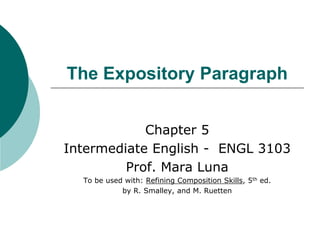
The expository paragraph
- 1. The Expository Paragraph Chapter 5 Intermediate English - ENGL 3103 Prof. Mara Luna To be used with: Refining Composition Skills, 5th ed. by R. Smalley, and M. Ruetten
- 2. Expository Paragraph Is a paragraph that explains and analyzes a topic giving you information, an explanation, facts, or a illustration. Expository comes from the term expose, meaning, “to reveal”. Although explaining a topic can be done in several ways, the most common approach to developing an expository paragraph requires using specific details and examples.
- 3. Five basic ways in which authors can organize information in expository text Description - in which a topic is introduced and followed by its attributes Sequence - in which a topic is introduced and followed by details that need to be presented in an order Cause/effect - in which an event or act and its effects are described Comparison/contrast - in which the similarities and differences in two or more things are presented Problem/solution - in which a problem is presented followed by one or more solutions
- 4. Types of Expository Text ABC books * editorials advertisements * instructions autobiographies * interviews biographies * invitations book reports * journals brochures * lab reports campaign speeches * letters cartoons * lists catalogues * maps comics * menus complaints * newspaper articles definitions * etc. directions
- 5. Organization and content of a paragraph A topic sentence must be supported with details organized chronologically in a narrative paragraph. Spatially in a descriptive paragraph. When you support the controlling idea with information, details, facts, or illustrations, in other words, when you explain or analyze a topic, you are doing an expository paragraph.
- 6. The most common approach to developing an expository paragraph Requires using specific details and examples. This is needed in order to support the controlling idea in your topic sentence. The controlling idea is the word or phrase in the topic sentence that states an idea or an attitude about the topic. This is frequently referred to as a generalization.
- 7. Generalization Is a statement that applies in most cases to a group of things, ideas, or people. A generalization can be a value judgment or an opinion or a factual statement. (p. 83)
- 8. Specific Details You need to provide some information or explanation about the controlling idea. Give “hard evidence” to support the controlling idea. You need to illustrate or “prove” or support the generalization. Specific details can help to achieve that. In expository writing, the writer is like a lawyer who is trying to prove a point. Good proof is factual detail.
- 9. Examples Is an item that represents a group of things, people, or ideas. In other words, an example is a specific representative of a general category. Examples make the controlling idea, clearer and more convincing and therefore are an effective means of support. It is not usually sufficient just to name an example; often it is necessary to explain the example to show how it relates to and supports the generalization.
- 10. Examples The explanation of an example does not have to be lengthy; sometimes all you need to do is add a few words. The writer could add a clause to explain the example. It is useful to provide specific detail for support.
- 11. Illustrations and Anecdotes It is not always necessary to give several examples to support the controlling idea, sometimes one example that is explained in greater detail will suffice to support the controlling idea. This kind of extended example is useful, not so much for “proving” the statement in the generalization but for illustrating it. This is why it is called an illustration. Another type of illustration is an anecdote. An anecdote is a brief story that dramatizes the point made in the generalization. It is a brief narrative.
- 12. COHERENCE Organization of Details and Examples When a paragraph contains several details and examples, it is necessary to consider the order of their presentation. The sentences in an expository paragraph follow no prescribed or set pattern of organization. The ordering depends on the subject and often on the author’s logic. Here are some patterns or guidelines:
- 13. Organization of Details and Examples 1. Order of Importance: Saving the best for last – Readers generally remember what they read last, and since it is good idea to leave a good impression on the reader, it is wise to place the most impressive example at the end of the paragraph. 2. Order of Familiarity: From the more familiar to the less familiar – When the details in the expository paragraph are mostly factual, it is common to begin with the most obvious or familiar detail and move toward the less obvious or less familiar detail.
- 14. Organization of Details and Examples 3. Order of Time: From the past to the present – When the details and examples in a paragraph are taken from history or are events that have taken place in the past, it is often a good idea to order the examples according to chronology.
- 15. Transitional Words or Phrases Not only should sentences and ideas in a paragraph be logically arranged, but they should flow smoothly as well. Expressions such as next, then, after that, and similar, signal time sequence. Expressions such as above, farther on, next to, and so forth, signal location. They are called transitional words and phrases.
- 16. Remember … There are many ways to achieve coherence; do not rely entirely on one way. Try to use a variety of coherence devices – a mixture of clauses, phrases, and transitional expressions. Do not overdo the use of transitions; it could be repetitious. Generally, two or three transitional expressions in a paragraph are sufficient.
